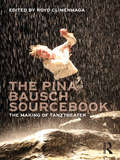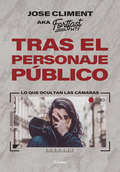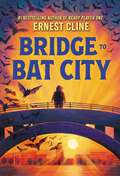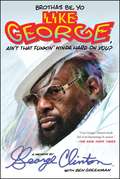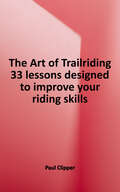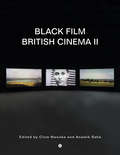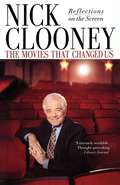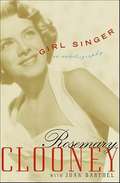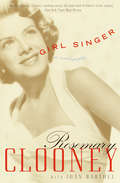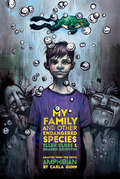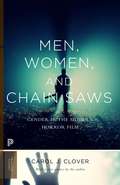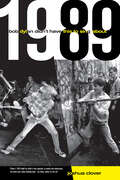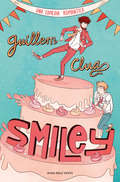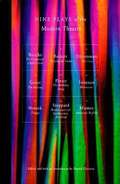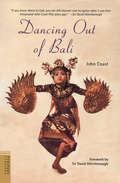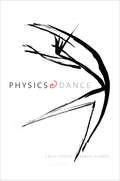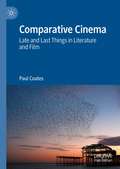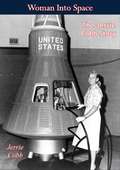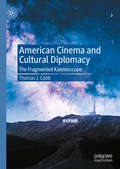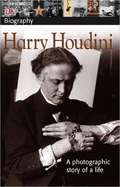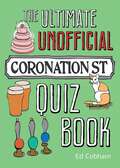- Table View
- List View
The Pina Bausch Sourcebook: The Making of Tanztheater
by Royd ClimenhagaPina Bausch’s work has had tremendous impact across the spectrum of late twentieth-century performance practice, helping to redefine the possibilities of what both dance and theater can be. This edited collection presents a compendium of source material and contextual essays that examine Pina Bausch's history, practice and legacy, and the development of Tanztheater as a new form, with sections including: Dance and theatre roots and connections; Bausch’s developmental process; The creation of Tanztheater; Bausch’s reception; Critical perspectives. Interviews, reviews and major essays chart the evolution of Bausch’s pioneering approach and explore this evocative new mode of performance. Edited by noted Bausch scholar, Royd Climenhaga, The Pina Bausch Sourcebook aims to open up Bausch’s performative world for students, scholars, dance and theatre artists and audiences everywhere.
Tras el personaje público
by José ClimentJordi Carrillo de Albornoz (Jordi Wild), Amarna Miller, Rocío Vidal (La Gata de Schrödinger), Luis Miguel Amor (Revenant), Rocío Camacho, Paul Alone, Carlos Santana (DotCSV), Javier Ivanyer (eh!), Elena Bueno, Nekane, Lisa JusticeDark, Luis Montilla (profesor de instituto) y David de Sousa (creativo publicista) son los invitados a este coloquio. Tras el personaje público aborda los pensamientos y reflexiones de los protagonistas del escenario online a través de entrevistas íntimas: ¿cómo se percibe la sociedad desde un altar de cientos de miles de seguidores?, ¿cuál es el precio de la fama?, ¿qué hay tras el personaje público? Comunicadores que han encontrado en la exposición mediática su forma de ganarse la vida, profesionales publicitarios responsables de las principales campañas de nuestro país y el testimonio de un docente en plena transformación digital.
Bridge to Bat City
by Ernest ClineFrom #1 New York Times bestselling author Ernest Cline comes a mostly true tall tale about an unexpected friendship between a young girl and a music-loving colony of bats. After losing her mother, thirteen-year-old Opal moves in with her uncle Roscoe on the family farm. There, Opal bonds with Uncle Roscoe over music and befriends a group of orphaned, music-loving bats. But just as the farm is starting to feel like home, the bats&’ cave is destroyed by a big mining company with its sights set on the farmland next. If Opal and the bats can fit in anywhere, it&’s the nearby city of Austin, home to their favorite music and a host of wonderfully eccentric characters. But with people afraid of the bats and determined to get rid of them, it&’ll take a whole lot of courage to prove that this is where the bats—and Opal—belong.
Brothas Be, Yo Like George, Ain't That Funkin' Kinda Hard On You?: A Memoir
by George Clinton**ONE OF THE BEST MUSIC BOOKS OF THE YEAR BY ROLLING STONE**The captivating memoir from &“the emperor of intergalactic funk&” (NPR) and most influential pop artists of our time—known for over forty R&B hit singles—George Clinton of Parliament-Funkadelic.George Clinton began his musical career in New Jersey, where his obsession with doo-wop and R&B led to a barbershop quartet—literally, as Clinton and his friends also styled hair in the local shop—the way kids often got their musical start in the &’50s. But how many kids like that ended up playing to tens of thousands of rabid fans alongside a diaper-clad guitarist? How many of them commissioned a spaceship and landed it onstage during concerts? How many put their stamp on four decades of pop music, from the mind-expanding sixties to the hip-hop-dominated nineties and beyond? One of them. That&’s how many. How George Clinton got from barbershop quartet to funk music megastar is a story for the ages. As a high school student, George traveled to New York City, where he absorbed all the trends in pop music, from traditional rhythm and blues to Motown, the Beatles, the Stones, and psychedelic rock, not to mention the formative funk of James Brown and Sly Stone. By the dawn of the seventies, he had emerged as the leader of a wildly creative musical movement composed mainly of two bands—Parliament and Funkadelic. And by the bicentennial, Clinton and his P-Funk empire were dominating the soul charts as well as the pop charts. He was an artistic visionary, visual icon, merry prankster, absurdist philosopher, and savvy businessmen, all rolled into one. He was like no one else in pop music, before or since. Written with wit, humor, and candor, this memoir provides tremendous insight into America&’s music industry as forever changed by Clinton&’s massive talent. This is a story of a beloved global icon who dedicated himself to spreading the gospel of funk music.
The Art of Trailriding: 33 Lessons Designed to Improve Your Riding Skills
by Paul ClipperYou can ride a dirt bike, but do you really feel comfortable on it, and confident that you know how to handle it in any situation? In The Art of Trailriding, author Paul Clipper, former staffer at Dirt Bike magazine and past owner of Trail Rider magazine, digs into his 40 years of off-road riding experience to explain in simple terms how your bike works and what you have to do to gain control. Clipper all about proper set-up, and then goes on to carefully details what to do and what to expect in specific riding circumstances.
Black Film British Cinema II
by Clive Nwonka and Anamik SahaThe politics of race in British screen culture over the last 30 years vis-a-vis the institutional, textual, cultural and political shifts that have occurred during this period.Black Film British Cinema II considers the politics of blackness in contemporary British cinema and visual practice. This second iteration of Black Film British Cinema, marking over 30 years since the ground-breaking ICA Documents 7 publication in 1988, continues this investigation by offering a crucial contemporary consideration of the textual, institutional, cultural and political shifts that have occurred from this period. It focuses on the practices, values and networks of collaborations that have shaped the development of black film culture and representation. But what is black British film? How do such films, however defined, produce meaning through visual culture, and what are the political, social and aesthetic motivations and effects? How are the new forms of black British film facilitating new modes of representation, authorship and exhibition? Explored in the context of film aesthetics, curatorship, exhibition and arts practice, and the politics of diversity policy, Black Film British Cinema II provides the platform for new scholars, thinkers and practitioners to coalesce on these central questions. It is explicitly interdisciplinary, operating at the intersections of film studies, media and communications, sociology, politics and cultural studies. Through a diverse range of perspectives and theoretical interventions that offer a combination of traditional chapters, long-form essays, shorter think pieces, and critical dialogues, Black Film British Cinema II is a comprehensive, sustained, wide ranging collection that offers new framework for understanding contemporary black film practices and the cultural and creative dimensions that shape the making of blackness and race.ContributorsBidisha, Ashley Clark, Shelley Cobb, James Harvey, Melanie Hoyes, Maryam Jameela, Kara Keeling, Oslem Koskal, Rabz Lansiquot, Sarita Malik, Richard Martin, So Mayer, Alessandra Raengo, Richard T. Rodríguez, Tess S. Skadegård Thorsen, Natalie Wreyford
The Movies That Changed Us: Reflections On The Screen
by Nick ClooneyTwenty movies that had an impact on society.
The Movies That Changed Us: Reflections on the Screen
by Nick ClooneyThere are movies we love, but only one movie in a thousand actually changes the way we live, the way we look at life, or the way we define entertainment. Broadcast journalist Nick Clooney, best known as the silver-haired movie host on the cable channel American Movie Classics, has selected twenty movies that changed us, some for the better, some for the worse. He starts with the recent past: Saving Private Ryan, a movie that changed the way people across the world view the American generation that fought World War Two; Star Wars, a motion picture so important that a missile defense system was named for it; and The Birth of a Nation, not only the first film to be hailed as the artistic equivalent to opera, literature, and painting, but also the first film to give a cloak of respectability to racial prejudice. Clooney's debate-starting distinctions will engage, delight, and challenge everyone who loves movies: Did Taxi Driver change the way we view individual violence? Did The Graduate change the way we view romance? Did Dr. Strangelove change the way we contemplate mass destruction? Did The Best Years of Our Lives alter our behavior toward veterans? And did Triumph of the Will almost help the Nazis win the war? Clooney ends with an epilogue on "The Movie That Never Was": the film that could have spurred the civil rights movement if only it had been made. "Sports changed things, the military changed things, and eventually the federal government changed things," Clooney writes, but in the matter of race, he concludes, the movies changed nothing. Thought-provoking, entertaining, and compulsively readable, The Movies That Changed Us will delight film fans of every generation.
Girl Singer: An Autobiography
by Rosemary Clooney Joan BarthelAt the top of her form and topping the charts, Rosemary Clooney looks back at a life of triumph and tragedy more dramatic than any work of fiction. Rosemary Clooney made her first public appearance at the age of three, on the stage of the Russell Theater in her hometown of Maysville, Kentucky, singing, "When Your Hair Has Turned to Silver," an odd but perhaps prophetic choice for one so young. She has been singing ever since: on local radio; with Tony Pastor's orchestra; in big-box-office Hollywood films; at the Hollywood Bowl, the London Palladium, and Carnegie Hall ; on her own television series; and at venues large and small across the country and around the world. The list of Clooney's friends and intimates reads like a who's who of show business royalty: Bing Crosby, Frank Sinatra, Marlene Dietrich, Tony Bennett, Janet Leigh, Humphrey Bogart, and Billie Holiday, to name just a few. She's known enormous professional triumphs and deep personal tragedies. At the age of twenty-five, Clooney married the erudite and respected actor Jose Ferrer, sixteen years her senior and light-years more sophisticated. Trouble started almost immediately when, on her honeymoon, she discovered that he had already been unfaithful. Finally, after having five children while she almost single-handedly supported the entire family and endured Ferrer's numerous, unrepentant infidelities, she filed for divorce. From there her life spiraled downward into depression, addiction to various prescription drugs, and then, in 1968, a breakdown and hospitalization. After years spent fighting her way back to the top, Clooney is married to one of her first and long-lost loves- a true fairy tale with a happy ending. She's been nominated for four Grammys in six years and has two albums at the top of the Billboard charts. In the words of one of Stephen Sondheim's Follies showgirls, she could well be singing, triumphantly, "I'm still here!"
Girl Singer: An Autobiography
by Rosemary Clooney Joan BarthelAt the top of her form and topping the charts, Rosemary Clooney looks back at a life of triumph and tragedy more dramatic than any work of fiction. Rosemary Clooney made her first public appearance at the age of three, on the stage of the Russell Theater in her hometown of Maysville, Kentucky, singing, "When Your Hair Has Turned to Silver," an odd but perhaps prophetic choice for one so young. She has been singing ever since: on local radio; with Tony Pastor's orchestra; in big-box-office Hollywood films; at the Hollywood Bowl, the London Palladium, and Carnegie Hall ; on her own television series; and at venues large and small across the country and around the world. The list of Clooney's friends and intimates reads like a who's who of show business royalty: Bing Crosby, Frank Sinatra, Marlene Dietrich, Tony Bennett, Janet Leigh, Humphrey Bogart, and Billie Holiday, to name just a few. She's known enormous professional triumphs and deep personal tragedies. At the age of twenty-five, Clooney married the erudite and respected actor Jose Ferrer, sixteen years her senior and light-years more sophisticated. Trouble started almost immediately when, on her honeymoon, she discovered that he had already been unfaithful. Finally, after having five children while she almost single-handedly supported the entire family and endured Ferrer's numerous, unrepentant infidelities, she filed for divorce. From there her life spiraled downward into depression, addiction to various prescription drugs, and then, in 1968, a breakdown and hospitalization. After years spent fighting her way back to the top, Clooney is married to one of her first and long-lost loves- a true fairy tale with a happy ending. She's been nominated for four Grammys in six years and has two albums at the top of theBillboardcharts. In the words of one of Stephen Sondheim's Follies showgirls, she could well be singing, triumphantly, "I'm still here!"
My Family and Other Endangered Species
by Ellen Close Braden GriffithsNine-year-old Phineas interprets the world through his encyclopedic knowledge of animals, but some human behaviour is just too puzzling. Take for example his mom, who insists he learn to fall asleep on his own, even though all young mammals sleep with their mothers; or his dad, who recently picked up and left the family, a behaviour quite unlike other mate-for-life animals. And then there’s the constant news from his favourite TV station, the Green Channel, about how humans are ruining the environment, a fact Phin is growing increasingly anxious about. So when his fourth-grade class gets a White’s tree frog as a pet, all of Phin’s anxieties come to a boil.
Men Women and Chain Saws: Gender in the Modern Horror Film
by Carol CloverInvestigating the popularity of the low-budget tradition, Carol Clover looks in particular at slasher, occult, and rape-revenge films. <P><P>Although such movies have been traditionally understood as offering only sadistic pleasures to their mostly male audiences, Clover demonstrates that they align spectators not with the male tormentor, but with the females tormented―notably the slasher movie's "final girls"―as they endure fear and degradation before rising to save themselves.
1989: Bob Dylan Didn't Have This to Sing About
by Joshua CloverIn a tour de force of lyrical theory, Joshua Clover boldly reimagines how we understand both pop music and its social context in a vibrant exploration of a year famously described as "the end of history." Amid the historic overturnings of 1989, including the fall of the Berlin Wall, pop music also experienced striking changes. Vividly conjuring cultural sensations and events, Clover tracks the emergence of seemingly disconnected phenomena--from grunge to acid house to gangsta rap--asking if "perhaps pop had been biding its time until 1989 came along to make sense of its sensibility." His analysis deftly moves among varied artists and genres including Public Enemy, N.W.A., Dr. Dre, De La Soul, The KLF, Nine Inch Nails, Nirvana, U2, Jesus Jones, the Scorpions, George Michael, Madonna, Roxette, and others. This elegantly written work, deliberately mirroring history as dialectical and ongoing, summons forth a new understanding of how "history had come out to meet pop as something more than a fairytale, or something less. A truth, a way of being."
Smiley
by Guillem CluaSmiley és una història d'amor en lletres majúscules. Una llegenda japonesa diu que quan dues persones estan destinades a estar juntes, un fil vermell invisible lligat al dit petit de la mà esquerra les uneix des del dia del seu naixement. Aquest fil no es pot trencar, i pot lligar-les per sempre, encara que siguin molt lluny l'una de l'altra i malgrat que puguin ser molt diferents. Aquest sembla el cas de l'Àlex i el Bruno, els protagonistes de la comèdia romàntica que ha emocionat milers d'espectadors arreu del món. Segurament no es fixarien mai l'un en l'altre, però un equívoc farà que el que ha començat com una cita qualsevol els acabi canviant la vida per sempre. Smiley és una història d'amor en lletres majúscules. Fa riure i emociona. Mostra les pors a les quals ens enfrontem quan ens enamorem i les contradiccions de les relacions afectives dins de la comunitat gai, marcades per l'influx de les noves tecnologies i les aplicacions de cites online. I, a la vegada, és una petita viquipèdia de l'ambient barceloní i un homenatge a les comèdies romàntiques de tota la vida, de Nora Ephron a Howard Hawks. Smiley és tot això i molt més, però per sobre de tot, és un cant a l'amor en totes les seves formes. Guillem Clua va estrenar Smiley, una història d'amor el 2012 a la diminuta Sala Flyhard de Barcelona. Interpretada per Ramon Pujol (Àlex) i Albert Triola (Bruno) i amb direcció de l'autor, l'obra va estar en cartell a diferents teatres de la ciutat i en gira per Catalunya gairebé tres anys. La benedicció del públic (d'allò més divers: parelles heterosexuals, grups d'àvies, famílies senceres...) va venir acompanyada de crítiques entusiastes i tota mena de reconeixements. Va fer temporada a Madrid i des d'aleshores ha voltat per tot el món en diverses produccions internacionals, de Santiago de Xile a Atenes, de Miami a Berlín, de Nàpols a Nova York. Les últimes ciutats on s'ha pogut veure són Brisbane (Austràlia) i Singapur. Smiley s'ha convertit així en un fenomen global, capaç de traslladar al mainstream una comèdia romàntica protagonitzada per dos homes, amb final feliç i petó de pel·lícula. Les relacions de parella, però, evolucionen. Algunes milloren i altres s'acaben... o es converteixen en tota una altra cosa. Què va ser de l'Àlex i el Bruno després d'aquell happy ending? Van aconseguir superar les seves diferències i formar una parella estable? Van ser monògams o van iniciar una relació oberta? Feliços o infeliços? Smiley, després de l'amor, estrenada a l'Aquitània Teatre el 2020, respon a totes aquestes preguntes i moltes més, perquè han canviat moltes coses des d'aquella primera cita del 2012. Barcelona ja no és la mateixa ciutat, i l'Àlex i el Bruno... tampoc: ara els preocupen la crisi dels quaranta, el matrimoni, el final de la joventut i la pèrdua de la innocència. Aquesta edició reuneix elstextos de Smiley, una història d'amor i Smiley, després de l'amor. I qui ho sap, potser l'any 2030 ens tornem a trobar amb l'Àlex i el Bruno amb una tercera part que molts espectadors i lectors ja esperen amb impaciència.
Nine Plays Of The Modern Theater: The Caucasian Chalk Circle - Waiting For Godot - The Visit - The Balcony - The Birthday Party - Rhinoceros - Tango - Rosencrantz And Guildenstern Are Dead - American Buffalo
by Harold ClurmanVladimir, the more “philosophical” of the two vagrants in Beckett’s Waiting for Godot, stiffens their morale by asking, “. . . what’s the good of losing heart now? We should have thought of it a million years ago, in the nineties!” What does this mean in the play’s context? What were the nineties that these bewildered blighters should recall them with regret? It was perhaps a time when they had not yet entered upon their agony. It was a time of certainty, a beautiful time-or so it seemed to them and to most of their contemporaries.
Dancing Out of Bali
by John Coast Richard Attenborough"If you know where to look, you can still discover and recognize what it was that intoxicating John Coast fifty years ago." -Sir David AttenboroughThis book is one of the great classics about Bali, now with dozens of illustrations and photographs.Dancing out of Bali is a fascinating personal account of a young Englishman who settled in a small house in Bali in the midst of the political turmoil that griped post-war Indonesia. There, he immersed himself in Balinese culture and made ambitious plans to bring a troupe of Balinese dancers and musicians to Europe and America. The book relates John Coast's daring and remarkable adventure that took him from revolution in Indonesia to the footlights of London and Broadway. Within a few weeks, the troupe had captured the hearts of audiences. Here are photographs of Bali and stories of the performer's magic island and of the enchanting dancers, including the beautiful 12-year-old Ni Gusti Raka. She became a star overnight and delighted audiences everywhere during the troupe's triumphant tour.It is also a story of Balinese culture and life in Bali-following the devastating Japanese occupation-of music and dancing in Bali, of many of the island's great performing dancers and musicians,
Dancing Out of Bali
by John Coast Richard Attenborough"It is Bali felt, understood, loved, communicated...Coast has a kind of word magic." --New York Herald TribuneThis book tells of a young Englishman, fresh out of a Japanese prison camp, and his Javanese wife, and how they leave Indonesia for the footlights of Broadway. This is a story of life, music, and dancing in Bali, with all the charm of the Balinese people. Dancing out of Bali is a truly remarkable personal adventure story for all readers, especially dance lovers.
Physics and Dance
by Emily Coates Sarah DemersA fascinating exploration of our reality through the eyes of a physicist and a dancer—and an engaging introduction to both disciplines From stepping out of our beds each morning to admiring the stars at night, we live in a world of motion, energy, space, and time. How do we understand the phenomena that shape our experience? How do we make sense of our physical realities? Two guides—a former member of New York City Ballet, Emily Coates, and a CERN particle physicist, Sarah Demers—show us how their respective disciplines can help us to understand both the quotidian and the deepest questions about the universe. Requiring no previous knowledge of dance or physics, this introduction covers the fundamentals while revealing how a dialogue between art and science can enrich our appreciation of both. Readers will come away with a broad cultural knowledge of Newtonian to quantum mechanics and classical to contemporary dance. Including problem sets and choreographic exercises to solidify understanding, this book will be of interest to anyone curious about physics or dance.
Comparative Cinema: Late and Last Things in Literature and Film
by Paul CoatesThis book comprises what may be called exercises in ‘comparative cinema’. Its focus on endings, near-endings and ‘late style’ is connected with the author’s argument that comparative criticism itself may constitute an endgame of criticism, arising at the moment at which societies or individuals relinquish primary adherence to one tradition or medium. The comparisons embrace different works and artistic media and primarily concern works of literature and film, though they also consider issues raised by the interrelationship of language and moving and still images, as well as inter- and intra-textuality. The works probed most fully are ones by Theo Angelopoulos, Ingmar Bergman, Harun Farocki, Theodor Fontane, Henry James, Krzysztof Kieślowski, Chang-dong Lee, Roman Polański, Thomas Pynchon, and Paul Schrader, while the key recurrent motifs are those of dusk, the horizon, the labyrinth, and the ruin.
Woman Into Space: The Jerrie Cobb Story
by Jerrie Cobb Jane ReikerFascinating autobiography of the pioneering female pilot and women’s advocate Jerrie Cobb.Jerrie Cobb (1931-2019) was teaching men to fly by the age of 19, and in her twenties set several records for speed, distance and altitude. She was part of the Mercury 13, a group of women who, in a privately funded venture in 1959, underwent the same physiological testing that the men of the Mercury 7 program were subjected to. She was the first of the group to undergo the testing and the only one to pass all three phases. Nevertheless she was not considered a candidate for space travel by NASA, though she was appointed as a consultant to the space program in 1961.
American Cinema and Cultural Diplomacy: The Fragmented Kaleidoscope
by Thomas J. CobbThis book contends that Hollywood films help illuminate the incongruities of various periods in American diplomacy. From the war film Bataan to the Revisionist Western The Wild Bunch, cinema has long reflected US foreign policy’s divisiveness both directly and allegorically. Beginning with the 1990s presidential drama The American President and concluding with Joker’s allegorical treatment of the Trump era, this book posits that the paradigms for political reflection are shifting in American film, from explicit subtexts surrounding US statecraft to covert representations of diplomatic disarray. It further argues that the International Relations theorist Walter Mead’s concept of a US polity dominated by contesting beliefs, or a ‘kaleidoscope’, permeates these changing paradigms. This synergy reveals a cultural milieu where foreign policy fissures are increasingly encoded by cinematic representation. The interdisciplinarity of this focus renders this book pertinent reading for scholars and students of American Studies, Film Studies and International Relations, along with those generally interested in Hollywood filmmakers and foreign policy.
Harry Houdini
by Vicki CobbDK's acclaimed DK Biography series tackles two of history's most colorful figures in Harry Houdini and Albert Einstein. Perfect for book reports or summer reading, the DK Biography series brings a new clarity and narrative voice to history's most colorful figures.
The Ultimate Unofficial Coronation Street Quiz
by Ed CobhamSo you think you're one of Corrie's biggest fans? Test your knowledge with this trivia quiz book. What faulty household item caused the death of Valerie Barlow in 1971? Who died after being run over by a Blackpool tram in 1989? If you’re more at home in The Rovers than anywhere else, these brain-teasing questions will be right up your street!
The Ultimate Unofficial Coronation Street Quiz
by Ed CobhamSo you think you're one of Corrie's biggest fans? Test your knowledge with this trivia quiz book. What faulty household item caused the death of Valerie Barlow in 1971? Who died after being run over by a Blackpool tram in 1989? If you’re more at home in The Rovers than anywhere else, these brain-teasing questions will be right up your street!
The Ultimate Unofficial Eastenders Quiz Book
by Ed CobhamSo you think you're one of Eastenders' biggest fans? Test your knowledge with this trivia quiz book:How many times has Sharon been married? What colour was the original exterior of the Queen Vic? If you think you’re practically a resident of the square, these brain teasing questions will drive you Dotty until you've got them all!
